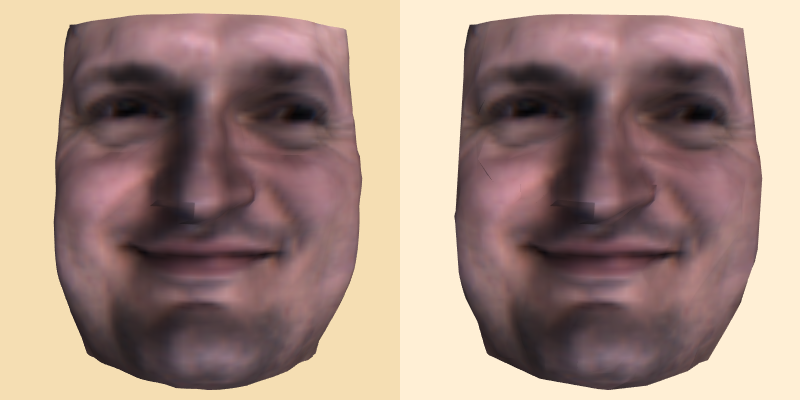DecimateFran
Repository source: DecimateFran
Description¶
This examples shows reduction on the order of 90 percent for a 10:1 compression ratio. the wireframe image are shown to accentuate the density of the polygonal meshes. The left-hand image is the original data; the right-hand image is the decimated mesh.
Info
See Figure 9-27a in Chapter 9 The VTK Textbook.
Other languages
See (Python)
Question
If you have a question about this example, please use the VTK Discourse Forum
Code¶
DecimateFran.cxx
#include <vtkActor.h>
#include <vtkCamera.h>
#include <vtkDecimatePro.h>
#include <vtkNamedColors.h>
#include <vtkNew.h>
#include <vtkPNGReader.h>
#include <vtkPolyDataMapper.h>
#include <vtkPolyDataNormals.h>
#include <vtkPolyDataReader.h>
#include <vtkProperty.h>
#include <vtkRenderWindow.h>
#include <vtkRenderWindowInteractor.h>
#include <vtkRenderer.h>
#include <vtkTexture.h>
int main(int argc, char* argv[])
{
if (argc < 3)
{
std::cout << "Usage: " << argv[0] << " fran_cut.vtk fran_cut.png"
<< std::endl;
return EXIT_FAILURE;
}
// This example shows how to use decimation to reduce a polygonal mesh. We
// also use mesh smoothing and generate surface normals to give a pleasing
// result.
//
// We start by reading some data that was originally captured from
// a Cyberware laser digitizing system.
//
vtkNew<vtkPolyDataReader> fran;
fran->SetFileName(argv[1]);
// Read the corresponding texture
vtkNew<vtkPNGReader> textureReader;
textureReader->SetFileName(argv[2]);
vtkNew<vtkTexture> texture;
texture->InterpolateOn();
texture->SetInputConnection(textureReader->GetOutputPort());
// We want to preserve topology (not let any cracks form). This may limit
// the total reduction possible, which we have specified at 90%.
//
vtkNew<vtkDecimatePro> deci;
deci->SetInputConnection(fran->GetOutputPort());
deci->SetTargetReduction(0.9);
deci->PreserveTopologyOn();
vtkNew<vtkPolyDataNormals> decimatedNormals;
decimatedNormals->SetInputConnection(deci->GetOutputPort());
decimatedNormals->FlipNormalsOn();
decimatedNormals->SetFeatureAngle(60);
vtkNew<vtkPolyDataNormals> originalNormals;
originalNormals->SetInputConnection(fran->GetOutputPort());
originalNormals->FlipNormalsOn();
originalNormals->SetFeatureAngle(60);
vtkNew<vtkNamedColors> colors;
vtkNew<vtkPolyDataMapper> decimatedMapper;
decimatedMapper->SetInputConnection(decimatedNormals->GetOutputPort());
vtkNew<vtkActor> decimatedActor;
decimatedActor->SetMapper(decimatedMapper);
decimatedActor->GetProperty()->SetAmbient(.5);
decimatedActor->GetProperty()->SetDiffuse(.5);
decimatedActor->SetTexture(texture);
vtkNew<vtkPolyDataMapper> originalMapper;
originalMapper->SetInputConnection(originalNormals->GetOutputPort());
vtkNew<vtkActor> originalActor;
originalActor->SetMapper(originalMapper);
originalActor->GetProperty()->SetAmbient(.5);
originalActor->GetProperty()->SetDiffuse(.5);
originalActor->SetTexture(texture);
// Create the RenderWindow, Renderer and both Actors
//
vtkNew<vtkRenderer> renderer1;
renderer1->SetViewport(0.0, 0.0, 0.5, 1.0);
vtkNew<vtkRenderer> renderer2;
renderer2->SetViewport(0.5, 0.0, 1.0, 1.0);
vtkNew<vtkRenderWindow> renderWindow;
renderWindow->AddRenderer(renderer1);
renderWindow->AddRenderer(renderer2);
renderWindow->SetWindowName("DecimateFran");
vtkNew<vtkRenderWindowInteractor> interactor;
interactor->SetRenderWindow(renderWindow);
// Add the actors to the renderer, set the background and size
//
renderer1->AddActor(originalActor);
renderer2->AddActor(decimatedActor);
renderer1->SetBackground(colors->GetColor3d("Wheat").GetData());
renderer2->SetBackground(colors->GetColor3d("Papaya_Whip").GetData());
renderWindow->SetSize(800, 400);
// render the image
//
vtkNew<vtkCamera> cam1;
cam1->SetClippingRange(0.0475572, 2.37786);
cam1->SetFocalPoint(0.052665, -0.129454, -0.0573973);
cam1->SetPosition(0.327637, -0.116299, -0.256418);
cam1->SetViewUp(-0.0225386, 0.999137, 0.034901);
renderer1->SetActiveCamera(cam1);
renderer2->SetActiveCamera(cam1);
renderWindow->Render();
interactor->Start();
return EXIT_SUCCESS;
}
CMakeLists.txt¶
cmake_minimum_required(VERSION 3.12 FATAL_ERROR)
project(DecimateFran)
find_package(VTK COMPONENTS
CommonColor
CommonCore
FiltersCore
IOImage
IOLegacy
InteractionStyle
RenderingContextOpenGL2
RenderingCore
RenderingFreeType
RenderingGL2PSOpenGL2
RenderingOpenGL2
)
if (NOT VTK_FOUND)
message(FATAL_ERROR "DecimateFran: Unable to find the VTK build folder.")
endif()
# Prevent a "command line is too long" failure in Windows.
set(CMAKE_NINJA_FORCE_RESPONSE_FILE "ON" CACHE BOOL "Force Ninja to use response files.")
add_executable(DecimateFran MACOSX_BUNDLE DecimateFran.cxx )
target_link_libraries(DecimateFran PRIVATE ${VTK_LIBRARIES}
)
# vtk_module_autoinit is needed
vtk_module_autoinit(
TARGETS DecimateFran
MODULES ${VTK_LIBRARIES}
)
Download and Build DecimateFran¶
Click here to download DecimateFran and its CMakeLists.txt file. Once the tarball DecimateFran.tar has been downloaded and extracted,
cd DecimateFran/build
If VTK is installed:
cmake ..
If VTK is not installed but compiled on your system, you will need to specify the path to your VTK build:
cmake -DVTK_DIR:PATH=/home/me/vtk_build ..
Build the project:
make
and run it:
./DecimateFran
WINDOWS USERS
Be sure to add the VTK bin directory to your path. This will resolve the VTK dll's at run time.
